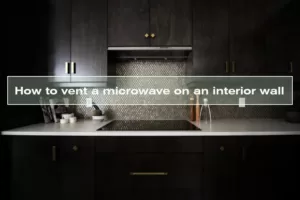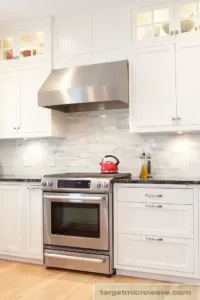If you’ve ever accidentally heated up food too quickly in the microwave now you may think about How to vent a microwave on an interior wall, and then be burned by the hot air that was released if not using steam microwave, this article is for you.
If there isn’t enough ventilation around these appliances, they will release toxic fumes into your kitchen which could make breathing difficult if you’re unaware they’re present due to cheap or low budget microwaves.
You must access your kitchen piping to vent a microwave on an inside wall in order to allow all hot air created by the microwave to escape.
You can use existing ductwork in your house, but if you don’t have quick access to existing ducting, you may need to build new ducts and channels.
You can’t take the microwave outside for venting. You need a venting system for your kitchens that properly vent the hot air & burning smell.
You’ll need a hole in your exterior wall where you can poke it out. If this is a second-floor unit, though, how will that work? We’ve got an answer for that too!
How to vent a microwave on an interior wall?
Most modern microwaves are fairly slim and lightweight enough to be vented through drywall or paneling.
In addition to being safe, they also won’t release any electrical fumes into your kitchen–or worse yet, onto someone else’s food!
As people remodel their kitchens with open layouts instead of inside walls between living and cooking spaces, we are seeing more of the outdoors.
Guidelines for how to vent a microwave on an interior wall
Here are some guidelines for how to vent a microwave on an interior wall.
- If you have a traditional, solid-wall kitchen with separate rooms and no door between the cooking space and living area.
- Your best option is through one of the exterior walls in either room.
- If that’s not available or if you want something more decorative than just drywall or paneling.
- You can also create ductwork from PVC pipe (which will require installing plywood or metal studs).
Recirculating venting microwave vs. vent a microwave
This might be necessary when replacing an older stove since some now come vented through the side as well so check before going any further! There are other options too but these may require other contractors like plumbers or electricians depending on your location and budget.

Recirculating venting microwave for How to vent a microwave on an interior wall:
Every kitchen out there has a vent. It’s important for the circulation of hot air in your cooking area, but it’s also crucial to keep that air from blowing all over the place and making it hard to prepare food.
Vent microwave hot air & burning smell for How to vent a microwave on an interior wall:
The ventilation system is an important feature for every kitchen. If you don’t have a ventilation system in your kitchen, you should have it the first priority, it will cost you some of your money but it helps you work more efficiently to clean your kitchen!
microwave oven venting options
A microwave oven is one of the most essential appliances in any kitchen. It can be used for a variety of chores, from cooking and reheating to defrosting or melting chocolate. However, it’s important to vent your microwave correctly so you don’t risk fire or carbon monoxide poisoning. Read on to find out how!
Conclusion paragraph: You might be wondering about the best option for venting your microwave oven. The answer to that question depends on where you live and what type of food is being cooked in it most frequently.
The two types of vents are external and internal, and both draw air from inside the appliance through different openings into your kitchen or living room. Vents mounted outside the wall with intake tubes take up less space than those mounted inside.
Internal vents require more installation time since they involve drilling a hole below the cabinet above (or next to) the unit so that there’s enough clearance for hot air to escape without any disturbance.


